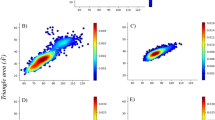Abstract
Flexibility is involved in a wide range of biological processes, such as protein assembly and binding recognition. EPSP synthase is an enzyme that must undergo a large conformational change to accommodate its ligands into its binding cavity. However, although the structure of EPSP synthase has been determined, its plasticity has not been explored in depth. Therefore, in this work, we extensively examined the influence of the flexibility of Mycobacterium tuberculosis EPSP (MtEPSP) synthase on the function of this protein using classical and replica-exchange metadynamics simulations. We were able to identify five well-populated conformational clusters for MtEPSP synthase: two corresponding to open, one to ajar, and two to closed conformations. We also pinpointed three hydrophobic regions that are responsible for guiding transitions among these states. Taken together, the new findings presented here indicate how the hydrophobic regions modulate the flexibility of MtEPSP synthase, and they highlight the importance of considering these dynamic features in drug design projects employing this enzyme as a target.

The flexibility of EPSP synthase as a function of the pincer angles








Similar content being viewed by others
References
Feixas F, Lindert S, Sinko W, McCammon JA (2014) Exploring the role of receptor flexibility in structure-based drug discovery. Biophys Chem 186:31–45
Klippenstein SJ, Pande VS, Truhlar DG (2014) Chemical kinetics and mechanisms of complex systems: a perspective on recent theoretical advances. J Am Chem Soc 136:528–546
Funke T, Healy-Fried ML, Han H, Alberg DG, Bartlett PA, Schönbrunn E (2007) Differential inhibition of class I and class II 5-enolpyruvylshikimate-3-phosphate synthases by tetrahedral reaction intermediate analogues. Biochemistry 46:13344–13351
Priestman M, Healy ML, Becker A, Alberg DG, Bartlett PA, Lushington GH, Schönbrunn E (2005) Interaction of phosphonate analogues of the tetrahedral reaction intermediate with 5-enolpyruvylshikimate-3-phosphate synthase in atomic detail. Biochemistry 44:3241–3248
Krekel F, Oecking C, Amrhein N, Macheroux P (1999) Substrate and inhibitor-induced conformational changes in the structurally related enzymes UDP-N-acetylglucosamine enolpyruvyl transferase (MurA) and 5-enolpyruvylshikimate 3-phosphate synthase (EPSPS). Biochemistry 38:8864–8878
Haghani K, Salmanian AH, Ranjbar B, Zakikhan-Alang K, Khajeh K (2008) Comparative studies of wild type Escherichia coli 5-enolpyruvylshikimate 3-phosphate synthase with three glyphosate-insensitive mutated forms: activity, stability and structural characterization. Biochim Biophys Acta 1784:1167–1175
Mizyed S, Wright JEI, Byczynski B, Berti PJ (2003) Identification of the catalytic residues of AroA (enolpyruvylshikimate 3-phosphate synthase) using partitioning analysis. Biochemistry 42:6986–6995
Hornak V, Abel R, Okur A, Strockbine B, Roitberg A, Simmerling C (2006) Comparison of multiple Amber force fields and development of improved protein backbone parameters. Proteins 65:712–725
Van Der Spoel D, Lindahl E, Hess B, Groenhof G, Mark AE, Berendsen HJC (2005) GROMACS: fast, flexible, and free. J Comput Chem 26:1701–1718
Tribello GA, Bonomi M, Branduardi D, Camilloni C, Bussi G (2014) PLUMED 2: new feathers for an old bird. Comput Phys Commun 185:604–613
Bonomi M, Branduardi D, Bussi G, Camilloni C, Provasi D, Donadio D, Marinelli F, Pietrucci F, Broglia RA, Parrinello M (2009) PLUMED: a portable plugin for free-energy calculations with molecular dynamics. Comput Phys Commun 180:1961–1972
Bonomi M, Bussi G, Camilloni C et al. (2016) PLUMED2 website. http://plumed.github.io/doc-v2.1/user-doc/html/index.html. Accessed 7 Dec 2016
Bussi G, Donadio D, Parrinello M (2007) Canonical sampling through velocity rescaling. J Chem Phys 126:014101
Berendsen HJC, Postma JPM, DiNola A, Haak JR (1984) Molecular dynamics with coupling to an external bath. J Chem Phys 81:3684–3690
Hess B, Bekker H, Berendsen HJC, Fraaije JGEM (1997) LINCS: a linear constraint solver for molecular simulations. J Comput Chem 18:1463–1472
Jorgensen WL, Chandrasekhar J, Madura JD, Impey RW, Klein ML (1983) Comparison of simple potential functions for simulating liquid water. J Chem Phys 79:926–935
Olsson MHM, SØndergaard CR, Rostkowski M, Jensen JH (2011) PROPKA3: consistent treatment of internal and surface residues in empirical pK a predictions. J Chem Theory Comput 7:525–537
Laio A, Parrinello M (2002) Escaping free-energy minima. PNAS 99:12562–12566
Formoso E, Limongelli V, Parrinello M (2015) Energetics and structural characterization of the large-scale functional motion of adenylate kinase. Sci Rep 5:8425
Leone V, Marinelli CP, Parrinello M (2010) Targeting biomolecular flexibility with metadynamics. Curr Opin Struct Biol 20:148–154
Sutto L, Marsili S, Gervasio FL (2012) New advances in metadynamics. WIREs Comput Mol Sci 2:771–779
Laio A, Rodriguez-Fortea A, Gervasio FL, Ceccarelli M, Parrinello M (2005) Assessing the accuracy of metadynamics. Phys Chem B 109:6714–6721
Branduardi D, Bussi G, Parrinello M (2012) Metadynamics with adaptive Gaussians. J Chem Theory Comput. 8:2247–2254
Schrödinger, LLC (2010) The PyMOL molecular graphics system, version 1.3r1. Schrödinger, LLC, New York
OriginLab Corp. (2017) Origin. OriginLab Corp., Northampton
Wolfram Research, Inc. (2015) Mathematica. Wolfram Research, Inc., Champaign
Vasilef I (2013) QtiPlot. University of Utrecht, Utrecht
Worth CL, Preissner R, Blundell TL (2011) SDM—a server for predicting effects of mutations on protein stability and malfunction. Nucleic Acids Res 39:215–222
Acknowledgments
We would like to thank Predrag Kukic for helpful discussion about the manuscript, and Ivani Pauli, Rafael A. Caceres, and José Fernando R. Bachega for their valuable suggestions.
Author information
Authors and Affiliations
Contributions
The manuscript was written through the contributions of all the authors. All authors gave their approval to the final version of the manuscript.
Corresponding author
Ethics declarations
Funding sources
This project was supported fully or in part by grants from the National Research Council of Brazil (CNPq) to O.N.S. (308,124/2015–4) and to D.S.S and L.A.B. via The National Institute of Science and Technology in Tuberculosis (DECIT/SCTIE/MS - MCT - CNPq - FNDCT - CAPES), and from FAPERGS to O.N.S. (TO2054–2551/13–0). D.S.S., L.A.B., and O.N.S. are Research Career Awardees of the CNPq. L.F.S.M.T. acknowledges Ph.D. scholarships awarded by CAPES. L.F.S.M.T. also thanks CNPq for a split Ph.D. fellowship (229,676/2013–8). R.W.M. acknowledges the São Paulo Research Foundation (FAPESP, grant #2011/11343–0). A.M.S.N. acknowledges Ph.D. scholarships awarded by FAPESP (grant #2013/18398–0).
Rights and permissions
About this article
Cite this article
Timmers, L.F.S.M., Neto, A.M.S., Montalvão, R.W. et al. EPSP synthase flexibility is determinant to its function: computational molecular dynamics and metadynamics studies. J Mol Model 23, 197 (2017). https://doi.org/10.1007/s00894-017-3372-2
Received:
Accepted:
Published:
DOI: https://doi.org/10.1007/s00894-017-3372-2




